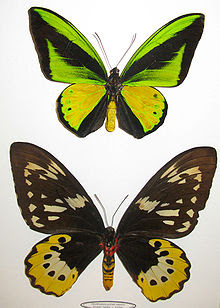The largest butterfly in the world is the Queen Alexandra's Birdwing found only in Papua New Guinea. The male and female look entirely different with the male, like some bird species, being the more colorful, but the female being the larger of the two. This photo will give you some perspective as to size.
Female Queen Alexandra's Birdwing
Photo by Eddie Malaisa Source: Things With Wings
The wingspan of the female can be up to a foot, while the male's wingspan is a few inches smaller (but still large enough for a butterfly).
Male Queen Alexandra's Birdwing Source: Curious Animals
Another spectacular birdwing is the Rajah Brooke's Birdwing found in Borneo, Sumatra, and West Malaysia.
Male Rajah Brooke's Birdgwing Source: Wikipedia
And the Southern Birdwing found in India has a very graphic design on the underside of its wings.
Source: Wikipedia
While it may be called the common green birdwing, there doesn't seem to be anything common about this butterfly at all.
While the next photo is not of a Birdwing, I just had to include this gorgeous thing - a Postman butterfly or Heliconius Melpomene found from Mexico to South America. There are many subspecies with similar markings and looks.
While this post won't go up until Monday, I'm writing it on Sunday and looking out the window at - you guessed it - more snow. We only got a few inches and it's already turning soupy and melting. Tomorrow (Monday) more rain.
The second largest butterfly in the world is the Goliath Birdwing. And again the male and female look entirely different. The Goliath is also found in New Guinea and a few adjacent islands.
(Male above, female below) Source: Wikipedia
While it may be called the common green birdwing, there doesn't seem to be anything common about this butterfly at all.
Photo by Nicole Duplaix Source: National Geographic
While the next photo is not of a Birdwing, I just had to include this gorgeous thing - a Postman butterfly or Heliconius Melpomene found from Mexico to South America. There are many subspecies with similar markings and looks.
Source: Wikipedia
While this post won't go up until Monday, I'm writing it on Sunday and looking out the window at - you guessed it - more snow. We only got a few inches and it's already turning soupy and melting. Tomorrow (Monday) more rain.




















































